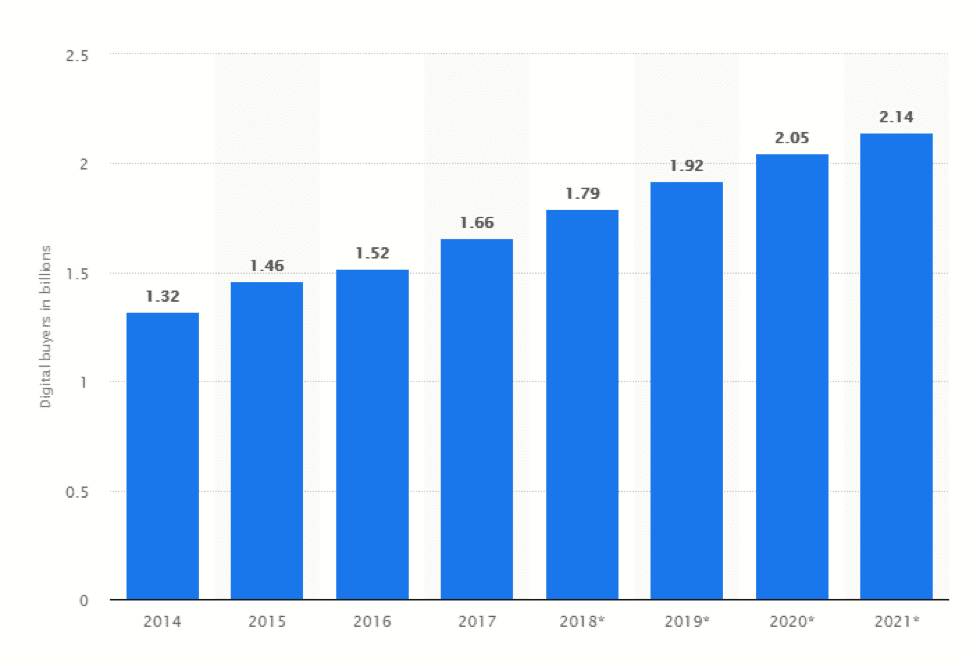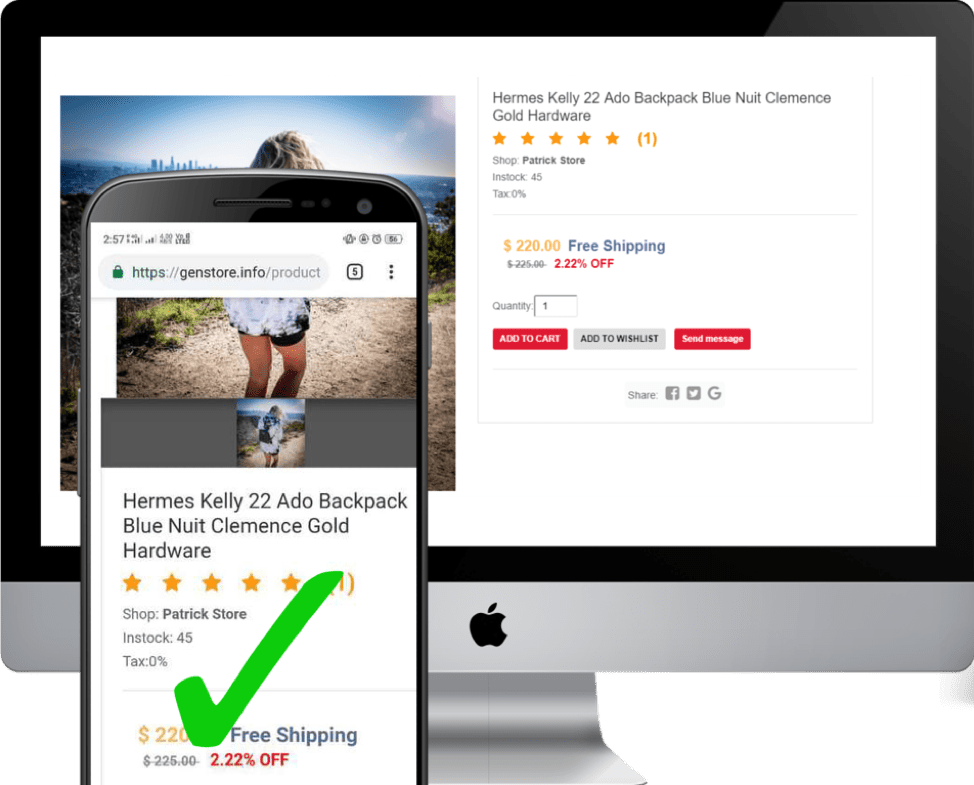E-Commerce is a colossal arena with gigantic arrays of business models. Today, eCommerce sites have become an inseparable part of our daily lives and somehow we tend to interact with them on a regular basis. From buying grocery supplies, picking up the latest fashions wares, booking an Uber, planning a holiday trip to calling an AC mechanic at home, everything is available online on the eCommerce sites.
According to Statista, more than 1.66 billion customers worldwide did online shopping of some kind from various eCommerce sites in 2017. They expect this number would only increase in the future and finally cross the $2.14 billion mark by the year 2021.
Well, that was in 2017, but now is 2019. Do you think eCommerce sites are the same as they were a few years back? Experts have anticipated this huge growth on the metrics combined with online sales, which includes a boundless differentiation in the eCommerce products and services types we would be seeing in the days to come.
We are not limited to physical products anymore
The eCommerce market today is not just about selling physical products anymore. It has evolved to accommodate an array of services and nobilities as well. You will get the point by checking out the following types of eCommerce sites we see in our daily lives these days. Today, we have an eCommerce site for anything we want to purchase or avail-
- Branded inventory based sites (Nike, Reebok)
- Marketplace product-based sites (Amazon, Alibaba, Walmart, Etsy)
- Digital products sites (Steam, Origin, Kindle, Apple iBooks, PrestaShop Add-ons)
- Service marketplace sites (Task rabbit, urban Clap, Thumbtack, Freelancer, Upwork )
- Ride-sharing sites (Uber, Ola, Lyft)
- C2C products sites (eBay )
- C2C Home rentals site (Nest away )
- Home sharing sites (Airbnb)
- Affiliate eCommerce sites (TheWireCutter -Amazon Affiliate)
- Drop shipping sites (Alibaba, Obrelo, Salehoo)
- E-Learning marketplace sites (Udemy, Coursera)
E-commerce market has grown drastically. With ever-growing market and new entrants joining the sphere, eCommerce has become a tough but a huge market for rulling. However, it doesn’t mean it has nothing for the new entrepreneurs.
Beat the heat with a perfect strategy
Despite this cut-throat competition, the online market is still a partially grown sphere. It still has a lot more in its trunk for the new entrepreneurs. There are unlimited business ideas, which when applied strategically can make you a success story in no time.
Amazon, Alibaba, Walmart, Etsy, etc. have been ruling the eCommerce space for a long time. However, still, businesses like Uber, Thumbtack, Freelancer, Upwork, and Airbnb, came and grabbed a huge share of the market. It happened because they knew they had to do something different. Instead of competing with what Amazon is offering, they offered what it’s not attempting. As a result, they are no less successful than the other eCommerce giants today.
You need a flawless eCommerce software
Call them eCommerce software, eCommerce platforms, eCommerce CMS, or eCommerce solutions, these are all different names for the same stuff. A software solution to start your eCommerce business. A software solution for your eCommerce website development.
E-Commerce platforms are one of the multiple ways to develop an eCommerce site in a quick time. Unlike the old days, you don’t have to go through the eCommerce website development from scratch anymore. There are various pre-developed eCommerce platforms in the market which allow you to-
- Use a ready-made eCommerce website
- Avoid development from scratch
- Pick up from a pre-developed platform
- Customize the platform on a requirement
- Finish website development in a quicker time
How to choose a worthy eCommerce platform?
E-Commerce platforms are twin-edged swords. An efficient software can make you a ruler in the market with an average business idea, but a wrong choice will only lead to a free-fall even with a perfect business plan.
However, you shouldn’t expect your site to be perfect at the beginning itself. An average eCommerce site goes through a series of evolutions to become a competent touchpoint. The market does expect you to adopt eCommerce software as per the latest standards. Today, the best eCommerce solution means a competent eCommerce software that lets you tackle the competition.
What makes a competent eCommerce solution?
The top eCommerce platforms in the market have gained the title not because they have everything or they are perfect. They are popular because of a precise blend of multiple factors that make a software contemporary. Following are the factors that you too should consider while choosing from the best eCommerce solutions in the market.
1. Pricing and payment model
E-Commerce platforms are sold by software companies in different models. There are popular and top eCommerce platforms in each model you are comfortable with. So the first aspect to consider is the software delivery model suitable to your budget and requirements. The two of the popular model are SaaS and Open-source models.
Facts about SaaS-based eCommerce platforms:
- Also called as hosted solutions
- Include monthly license fee
- Come without source code access
- Include other miscellaneous fees
- Generally, come with a low upfront cost
- Limited Scalability & dependent on vendors
- No code customizability
- You don’t own the software
- Quickest website deployment
- No hassles of website maintenance
- Highly secured by the cloud servers
Facts about Open-source code platforms:
- Also called as self-hosted/eCommerce CMS
- Access to the source code
- One time buying cost/ no monthly fee
- Generally, a large upfront cost of buying
- You can own the software for good
- A higher degree of customizability
- A greater degree of store scalability
- Generally slower deployment speed
- Full control and responsibility of the website
Both the delivery models provide the best eCommerce solutions with their own set of pros and cons. The self-hosted model is the oldest model, which has been in practice from the beginning. However, the need for SaaS model appeared to reduce the hassles of website deployment, hosting, and maintenance from the entrepreneurs. The software is delivered as a service and source code access is revoked. On this cost, the SaaS vendors let you enjoy hassle-free management and focus more on business development.
While the Self-hosted model is still preferred by the entrepreneurs with the technical background. They know they would get an uncompromised control over their site if they can afford to maintain the site by their own. The source code access opens doors to unlimited customizability and options to scale the software on a requirement. Entrepreneurs get complete ownership of a custom eCommerce platform with the self-hosted delivery model.
2. Third-party integration
Be it any model, you should not overlook the possibilities to integrate plugins, extension, and popular APIs on your platform. The affinity to further integrations allows your platform to incorporate popular features without developing them from scratch.
For example, if you need great analytics for your site, it’s better to integrate Google Analytics than developing the same of your own. Furthermore, you will need multiple payment gateways on your site. If you choose to develop your own payment processor, you deviate from your primary business activity. Hence, integrating a PayPal or Stripe API is a better solution.
The eCommerce website needs to integrate several other APIs and modules to become competent. It’s always advised to ensure it is capable of integrating at least the popular third-party solutions. Examples of a few popular integrations are as follows:
- Accounting tools
- ERP tools
- Email Marketing tools
- Push notification tools
- Payment Gateways
- Analytic tools
- Web service for mobile apps
- Inventory management tools
- Social media integrations
- Live chat APIs
- Ticket Management APIs etc.
3. SEO friendly architecture
E-commerce and SEO go hand in hand. You cannot survive long with just paid Ads. At some point in time, would need people to find your store organically via search engines. For this, you need to grab a higher rank on the popular SERPs like Google and Bing.
Ensure your platform provides enough features and options to optimize your web store for the search engines. Here are a few of the important aspects that make an eCommerce platform SEO friendly:
- SEO friendly URLs
- Integrated CMS
- Meta tags
- Meta Descriptions
- Image Captions
- Product descriptions
- Structured Sitemap
- Support for SEO tools etc.
4. Mobile friendly UI and UX
Mobile friendliness is not just an aspect for SEO but also a crucial factor that optimizes the conversion rates. About 60% of the product searches are done on mobile and tablet devices. In such a situation, you do not want to offer a broken Mobile UI to your customers.
You need an eCommerce platform that offers the best mobile responsiveness to the end-users. The users must be given a similar level of UX on mobile like your desktop site. For example, they should be able to browse the site without any design issue and the UI should be designed to let them make a purchase without any difficulty.
For example, this mobile responsive Genstore product page looks great in this mobile view. It offers the same ease of shopping in the mobile view too:
If it wasn’t mobile responsive, the site would have been presented to the mobile users like below. This view is difficult to be used on a small screen where users will struggle to even tap on a button:
5. Scalability of the platform
We all aim to grow our business in the future. Not knowing the consequences, sometimes you choose a good looking platform that works best for the startup period. However, as the website grows, more products get listed, and more people start coming to your site, you start facing the scalability issues.
Now you are ready to pay for more server space and CDN services to make your site fast, but this does not help. Since the tech stack of your eCommerce platform is not competent to handle the higher load, you cannot scale your site by third-party implementations.
That’s why it’s important to consider the tech stack of your platform before investing in it. Keep your future plans into consideration and choose a platform capable of handling heavy loads. For example, the LAMP stack-based PHP sites generally perform best for the small and medium-sized businesses. However, the giant websites like Amazon, eBay, and Flipkart, etc. depend on MEAN stack-based Node js eCommerce development.
Node js is a perfect technology to develop highly scalable solutions because of its non-blocking I/O model. It purely JavaScript on both the front and the server side. As a result, it gives minimal stress to the server and processes the requests faster. You can check the Demo of our Genstore Node js eCommerce platform by yourself to experience the difference.
6. Security of the website
It’s undoubtedly the most important aspect of any eCommerce business. A lot of customer data, payment information, and monetary transactions make eCommerce sites favorite targets of hackers.
You do not want any loopholes in your site. For this, ensure that the platform is compliant to all the security standards. For example-
- It is using PCI-DSS compliant payment solutions
- It is capable of holding SSL certificates
- The developers have followed the standard code practice
- Vendors are releasing security patches regularly
Website security becomes your sole responsibility when choosing self-hosted eCommerce platforms. You might want to relax a bit in this regard if you choose a SaaS platform. However, you still need to stay cautious if the SaaS vendor is managing the security properly on their end.
7. Customizability of the base-code
Customizability of an eCommerce platform is a relative term in both the types of eCommerce platforms. For SaaS platforms, customizability is all about the availability of a large number of extra modules and Add-ons from the vendor. You cannot expect to get the ode access and modify it to add new features or remove a feature. Though platforms like Shopify allow authorized developers to add modules, it is still API based not the source code based.
However, the self-hosted side of the eCommerce platforms gives unlimited customizability as you can access the source code. For example, Magento, PrestaShop, and OpenCart are some popular self-hosted eCommerce platforms. They allow third-party developers to customize the platform with their modules and extensions. Similarly, Genstore also offers code access, which you can modify to add as many new features or revamp the UI itself.
So, comprehend the relativity of customizability first before choosing a platform for your cause.
Checklist: Top features to look in an eCommerce platform
Following are some important features that every eCommerce site should offer to the business owners. The best eCommerce solutions might offer these features by default or through customization in the base code. Many ready-made platforms also allow third-party modules to support such features.
- Store Management System
- Multi-shop system
- Set site offline/online
- Product Management System
- Direct Product Upload
- CSV Product Upload
- Enable/Disable products
- Analytics Management System
- Sells analytics
- Payments Analytics
- Product Analytics
- Traffic Analytics
- Return Management System
- Return request
- Set return rules
- Generate return invoice
- Approve/disapprove a request
- Shipping Management System
- Add new shipping options
- Map shipping options to products
- Set shipping option rules
- Discount Management System
- Create coupon codes
- Set coupon rules
- Set a flat discount
- Set percentage discount
- Set a special price for a limited time
- Payment Gateway Management
- Add new payment methods
- Enable/disable payment methods
- Map payments methods to products
- Content Management System
- Add new pages
- Manage site pages
- Manage blogs
- Review and Rating Management
- Write review
- Give ratting
- Approve/disapprove reviews
- Map reviews to product pages
- Marketing Management System
- Email marketing
- Affiliate Marketing
- Abandoned cart Management
- Back-in-Stock alerts
- Push Notifications
- Exit Pop-up
- Customer Support Management
- Email support
- Ticket Management System
- Live Chat
- Integrated Chatbot
- Marketplace Management System (if choosing the marketplace model of business)
- Seller Management
- Seller review Management
- Seller-Admin support system
- Marketplace Monetization
- Subscription management
- Commission Management
- Featured products Ads
Beyond Features
Lastly, I would recommend choosing a platform from a vendor that offers the best customer support. E-commerce is a risky business and you might lose millions in just a few minutes. If anything goes wrong, you want your vendor to offer the quickest technical support. So never overlook the support quality before selecting the best eCommerce platform for your business. I might consider a platform with few inbuilt features and good customizability, but not a platform with bad customer support. You can add new features later on, but you cannot replenish what’s lost due to a sudden crash or technical error.



